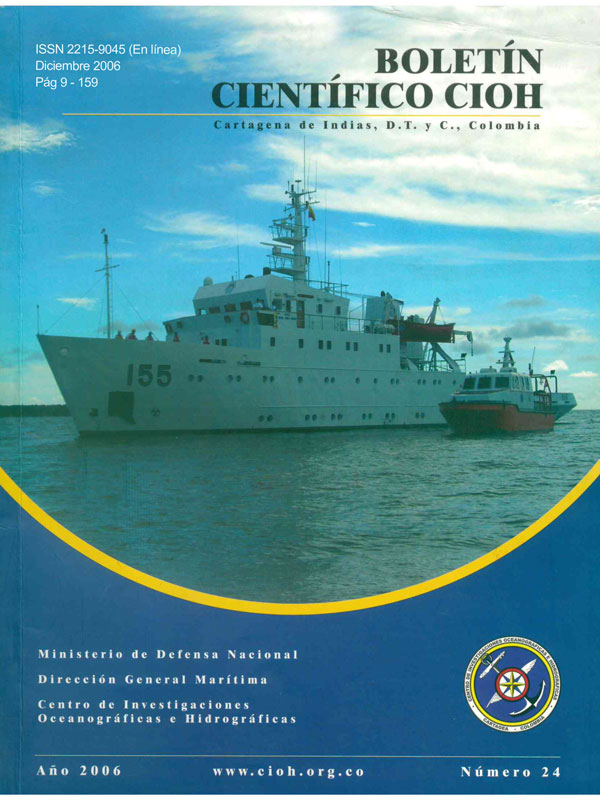A model of flocculation in suspension
DOI:
https://doi.org/10.26640/22159045.146Keywords:
Lagrangian modelling, flocculation, cohesive sedimentsAbstract
A lagrangian model applied to dynamics of floes considering fine mineral particles in suspension is presented here. The model describes in discrete way the turbulent motion of particles, their sedimentation depending on the aggregates grain size and the interaction processes to reach floes aggregation and disaggregation. Based on multiple numerical experiments, a parameterization of the flocculation process is proposed as a function of concentration of floes in suspension and the fluid turbulent kinetic energy. For elemental particles of 10pm, Reynolds stress of 2.34 Nm2 and concentrations between 1 and 550mg 1 1, the gaussian spectral distribution of floe sizes was obtained. Increasing the stress, this spectrum tends to be flatter until all floes disappear. In addition, this modeling study has achieved the Dyer's graphical concept about the flocculation. In general, under the predefined experimental conditions, areas on able representation of floes dynamics was obtained for simulations in complex hydrodynamic models. The parameterizations used here are suggested to perform predictions for cohesive sediments.Downloads
References
[2] Krone R. Flum estudies of the transport of sedimentin estuarial shoaling processes. Hydr. Eng. Lab.: Univ. of Berkeley, California; 1962.
[3] Lonin S, Parra C, Andrade C, Thomas Yv. Patrones de la pluma turbia del Canal del Dique en la Bahía de Cartagena. Boletín Científico CIOH. 2004; 22: 77-89.
[4] Thomas Yv, Cesaraccio M, Kunesch S, Andrieu A, Menanteau L, Andrade C, et al. Etude morphodynamique de la baie de Carthagene des Indes, Colombia. Milieux Littoraux, Nouvelles perspectives d'etude; Journees de la Commission de Geographie de la Meretdu Litoral. 2004: 171-191.
[5] Thomas Yv, Menanteau L, Kunesch S, Cesaraccio M, Andrade C, Lonin S, et al. Le delta du canal du Dique (baie de Carthagéne des Indes, Colombie). Modélisation géomorphologique et sédimentologique. Interactions Nature-Société, analyse et modéles. 2006; UMR6554 LETG, La Baule: 1-7.
[6] Burban P, Xu Y, Mc Neil J, Lick W. Settling speeds on floes in fresh water and seawater. J. of Geophys. Res. 1990; 95 (C10): 18, 213-18,220.
[7] Dyer K. Sediment processes in estuaries: future research requirements. J. Geophys. Res. 1989; 94 (CIO): 14, 327-14, 339.
[8] Trento A. Dinâmica da Floculação no Transporte de Sedimentos Finos [Tese Doutorado em Engenharia Civil]. Rio de Janeiro; Universida de Federal do Rio de Janeiro; 2005.
[9] Manning A, Dyer K. A laboratory examination of floe characteristics with regard to turbulent shearing, Marine Geology. 1999; 160: 147-170.
[10] Lonin S. Lagrangian model for oil spil ldiffusion at sea. Spill Science & Technology Bulletin. 1999; 5 (5/5-6): 331-336.
[11] Serra T, Casamitjana X. Effect of the Shearand Volume Fraction on the Aggregation and Break-up of particle. American Institute of Chemical Engineers. 1998; 44 (8/1724-1730.
[12] Maggi F. Flocculation dynamics of cohesive sediment [Ph.D. Thesis]. Delft: University of Technology; 2005.35
Downloads
Published
Issue
Section
License
Attribution — You must give appropriate credit, provide a link to the license, and indicate if changes were made. You may do so in any reasonable manner, but not in any way that suggests the licensor endorses you or your use.
NonCommercial — You may not use the material for commercial purposes.
NoDerivatives — If you remix, transform, or build upon the material, you may not distribute the modified material.
No additional restrictions — You may not apply legal terms or technological measures that legally restrict others from doing anything the license permits.



